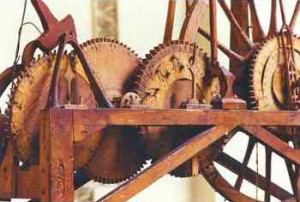John Muir’s Early-Rising Genius
Posted on April 1, 2012
Filed Under Technology | Leave a Comment
We don’t have the space to review the Make blog’s post on “John Muir’s Maker Days” as extensively as it deserves. We’ll simply note that Muir’s youth revealed the ravenous appetite for discovery and application that underlies a lot of technological gains. (We hope it’s not stretching a point to align Muir with technology, but it seems appropriate in the following context.)
Growing up in Wisconsin, the great naturalist and founder of the Sierra Club (and our National Park System) would get up at 1 a.m., hold a candle to the kitchen clock and find that he had gained five hours. “‘I had gained almost half a day. ‘Five hours to myself!’,’ I said, ‘five huge, solid hours!’ I can hardly think of any other event in my life, any discovery I ever made that gave birth to joy so transportingly glorious as the possession of these five frosty hours.'”
Working in his frigid basement, Make continues, Muir used his extra time to design a self-setting sawmill (to provide extra wood to heat the house on zero-degree mornings), “speedily followed by a lot of others – water wheels, curious doorlocks and latches, thermometers, hygrometers, pyrometers, clocks, a barometer, an automatic contrivance for feeding the horses at any required hour, a lamp-lighter and fire-lighter, an early-or-late-rising machine, and so forth.”
Inventiveness may need to be more abstract these days, and who needs to worry about keeping candles lit to stay with it? But the zeal for discovery and application is the key factor that drove Muir and that inspires anyone with a creative bent.
Learning is the fuse. “‘After the sawmill was proved and discharged from my mind,’ Muir wrote, ‘I happened to think it would be a fine thing to make a timekeeper which would tell the day of the week and the day of the month, as well as strike like a common clock and point out the hours; also to have an attachment whereby it could be connected with a bedstead to set me on my feet any hour in the morning; also to start fires, light lamps, etc. I had learned the time laws of the pendulum from a book, but with this exception I knew nothing of timekeepers, for I had never seen the inside of any sort of clock or watch.
“‘After long brooding,’ Muir continued ‘the novel clock was at length completed in my mind, and was tried and found to be durable and to work well and look well before I had begun to build it in wood. I carried small parts of it in my pocket to whittle at when I was out at work on the farm, using every spare or stolen moment within reach without father’s knowing anything about it.'”
Muir’s Scottish pastor father frowned on anything not directly connected with farm work. And, of course, he discovered his son’s “mysterious machine back of the bedstead” in the spare bedroom where Muir was working on it.
“”John,’ he inquired, ‘what is that thing you are making upstairs?’
“”I replied in desperation that I didn’t know what to call it.’
“”What! You mean to say you don’t know what you are trying to do?’
“”Oh, yes,’I said, ‘I know very well what I am doing.’
“‘What, then, is the thing for?’
“‘It’s for a lot of things,’ I replied, ‘but getting people up early in the morning is one of the main things it is intended for; therefore it might perhaps be called an early-rising machine.'”
Early-rising – that encapsulates the sprit behind discovery and inventiveness. Keeping ahead of a given day’s realities is what’s necessary to get beyond the present and contribute to the future, your own or the world’s. John Muir certainly demonstrated that. – Doug Bedell
Comments
Leave a Comment
If you would like to make a comment, please fill out the form below.
Recently
- Presentations With Forethought
- Technical Writing’s Lineage – Surely It’s Deeper than Digital
- At the Holidays, Twitting Amazon
- Successful Cookie Baking – From Mom, an Acknowledged Expert
- Slides for a Tech Writer’s Craft
- Digital or Not, Be Clear
- Being Watchful About Digital Designs…
- When Proposals Don’t Click, Keep Making Them Anyway
- Like a Good Gardener, Help an Enterprise Keep Itself Current
- We’re Leaders All, And Need to Think That Way
Categories
Archives
- January 2017
- December 2016
- November 2016
- October 2016
- September 2016
- August 2016
- July 2016
- June 2016
- May 2016
- April 2016
- March 2016
- February 2016
- January 2016
- December 2015
- November 2015
- October 2015
- September 2015
- August 2015
- July 2015
- June 2015
- May 2015
- April 2015
- March 2015
- February 2015
- January 2015
- December 2014
- November 2014
- October 2014
- March 2014
- February 2014
- January 2014
- December 2013
- November 2013
- October 2013
- September 2013
- August 2013
- July 2013
- June 2013
- May 2013
- April 2013
- March 2013
- February 2013
- January 2013
- December 2012
- November 2012
- October 2012
- September 2012
- August 2012
- July 2012
- June 2012
- May 2012
- April 2012
- March 2012
- February 2012
- January 2012
- December 2011
- November 2011
- October 2011
- September 2011
- August 2011
- July 2011
- June 2011
- May 2011
- April 2011
- March 2011
- February 2011
- January 2011
- December 2010
- November 2010
- October 2010
- September 2010
- August 2010
- July 2010
- June 2010
- May 2010
- April 2010
- March 2010
- February 2010
- January 2010
Blogroll
